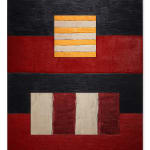
Sean Scully Irish-American, 1945
Red Light, 1999
Oil on linen, mounted on board, in 3 joined parts
243.8 x 213.4 cm. (96 x 84 in.)
Copyright The Artist
